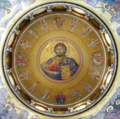Miaphysitism
Miaphysitism is the christology of the Oriental Orthodox Churches. It has often been considered by Chalcedonian Christians to be a form of Monophysitism, but the Oriental Orthodox Churches themselves reject this characterization, a position which the Eastern Orthodox and Roman Catholic Churches have begun to take more seriously (see external links below). Miaphysitism holds that in the one person of Jesus Christ, the nature of Divinity and the nature of Humanity are united in one "nature" ("physis"), the two being united without separation, without confusion, and without alteration. It evolved as a response to Nestorianism. As Nestorianism had its roots in the Antiochene tradition and was opposed by the Alexandrian tradition, it took hold in Syria among those who wanted to distance themselves from the extremes of Nestorianism, and in Egypt, among those who wished to uphold the integrity of their theological position.
The theology of miaphysitism is based on an understanding of the nature (Greek φύσις physis) of Christ: divine and human. After steering between the heresies of docetism (that Christ only appeared to be human) and adoptionism (that Christ was a man chosen by God), the church began to explore the mystery of Christ's nature further. Having agreed that Christ is both divine and human, the first difficulty was Nestorianism, which was perceived as stressing the two natures of Christ to such an extent that it appeared, to opponents, that two persons were living in the same body. The reaction to this was monophysitism, which stressed that Christ has but one, single nature that is both divine and human (at its most extreme, this was called eutychianism). Both of these positions were seen as heretical, but the church remained divided on how best to formulate a response to these. Cyril of Alexandria's works were the basis of the stance of miaphysitism. he spoke of the "one (mia) nature of the Word of God incarnate" (μία φύσις τοῦ θεοῦ λόγου σεσαρκωμένη mia physis tou theou logou sesarkōmenē) and a "union according to hypostases" (ἕνωσις καθ' ὑπόστασιν henōsis kath' hypostasin), or hypostatic union. The distinction of this stance was that the incarnate Christ has one nature, but that nature is of the two natures, divine and human, and retains all the characteristics of both. However, opponents of those who took this stance regarded it as nothing more than monophysitism. The alternative response, which eventualy became Byzantine dogma, was dyophysitism. This states that Christ has two natures, but emphasises that they are not separated: Christ is fully one person (ὑπόστασις hypostasis). The miaphysites regarded this as verging on Nestorianism.
The Council of Chalcedon (451) is often seen as a watershed for christology, as it adopted dyophysitism. However, as large portions of the church in Syria and Egypt, who held to miaphysitism, rebelled against the decision, the controversy became a major socio-political problem for the Byzantine Empire. There were numerous attempts at reunion between the two camps (including the Henoticon in 482), and the balance of power shifted several times. However, the decision at Chalcedon remains the official teaching of the Eastern Orthodox Church, the Roman Catholic Church and traditional Protestants. The anti-Chalcedonian churches are usually grouped together as Oriental Orthodox. Over recent decades, leaders of the various churches have spoken about the differences between their respective christologies as not being as extreme as was traditionally held.
Much has been said about the difficulties in understanding the Greek technical terms used in these controvesies. The main words are ousia (οὐσία, 'essence'), physis (φύσις, 'nature'), hypostasis (ὑπόστασις, 'concrete reality/person') and prosopon (πρόσωπον, 'mask/person'). Even in Greek, their meaning can overlap somewhat. These difficulties became even more exaggerated when these technical terms were translated into other languages. In Syriac, physis was translated as kyānâ (ܟܝܢܐ) and hypostasis was qnômâ (ܩܢܘܡܐ). The shades of meaning are even more blurred between these words, and they could not be used in such a philosophical way as their Greek counterparts. Thus, it has been suggested that miaphysitism came about due to a grounding of language in the fact that someone's person and nature are a verisimilitude.
As stated, the Churches of the Oriental Orthodox Communion, while sometimes called monophysite, vehemently reject that label. These include the Armenian Apostolic Church, the Syrian Orthodox Church, the Indian Orthodox Church, the Coptic Orthodox Church, the Ethiopian Orthodox Tewahedo Church (tewahido is a Ge'ez word meaning 'being made one') and the newly autocephalous Eritrean Orthodox Church.
One or more of the Independent Catholic Churches, while not being in full communion with the above Churches for various reasons, also embrace this Christology. These include the Antiochian Catholic Church in America. In recent theological discourses, some Old-Catholic and Anglican theologians have begun to embrace this Christology as being consistent with, though different from, the Chalcedon formulation.
See also
- Acephali, Henotikon and the Three-Chapter Controversy
- Coptic interpretations of the Fourth Ecumenical Council
- Pope Shenouda III: The Nature of Christ (PDF)
References
- Ethiopian Orthodox Tewahedo Church
- Agreed Statements between representatives of the Oriental and Eastern Orthodox Churches
- Joint declarations between the Syriac Orthodox and Roman Catholic Churches
- Syriac Orthodox Resources
- Old-Catholic/Anglican Theological Faculties
| Part of a series on |
| Eastern Christianity |
|---|
 |